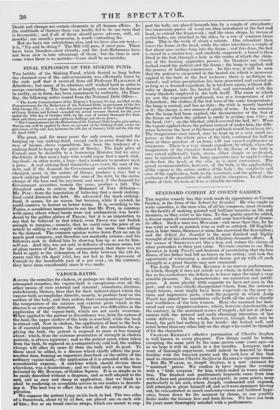VAPOUR-BATHS.
AMONG the remedies for cholera, or perhaps we should rather say, attempted remedies, the vapour-bath is conspicuous over all the other means of cure external and internal : stimulants, frictions, rubefacients, blisters, have that for their indirect object which the vapour-bath accomplishes directly, namely, to produce heat on the surface of the body, and thus restore that correspondence between the temperature of the interior and exterior parts which in the disease is so strangely disturbed. There are two difficulties in the application of the vapour-bath, which are not easily overcome. When applied to the patient in the ordinary way, from the nature of the heat, the upper surface of the body is scorched, while the back is almost cold. Now in cholera, the application of heat to the back is of essential importance. In the whole of the machines for ap- plying the bath, the patient is exposed to more or less tossing about; which, from the extreme prostration of strength in cholera patients, is always injurious; and as the patient must, when taken from the bath, be replaced on a comparatively cold bed, the sudden change will often do more ill than the bath will do good. To these must be added, in a disease which chiefly affects the poor, another item, forming an important drawback on the utility of the ordinary vapour-bath,—the application of it is attended with no in- considerable expense. A machine which should obviate these objections, was a desideratum and we think such a one has been invented by Mr. BTIRNET, of Golden Square. It is so simple as to be easily described without a diagram, and so well adapted to the end, and so easy and cheap in application, that we think we shall be rendering an acceptable service to our readers in describ- ing it. The best way to effect this is to show the steps of its ap- plication. We suppose the patient lying on his back in bed. The two sides of a framework, about 6 by 2i feet, are placed one on each side of him; five or six broad canvas straps, which are meant to sup- port his body, are placed beneath him by a couple of attendants; two transverse pieces of wood are then introduced at the foot and. head, to extend, the framework ; and the cross straps, by means of eyelet-holes, are attached to the sides, by a row of common brass. pins. This is the work of about a minute. One attendant then raises the frame at the head, while the other introduces a couple of feet about nine inches long into the frame ; and this done, the foot is raised in a similar way, and similarly supported; a board is then. fitted to the foot, through a hole in the centre of which the chim- ney of the heating apparatus passes; the blankets are closely tucked round the patient and the frame ; the lamp is applied, and the process of bathing commences. In this way, it will be seen that the patient is suspended in the heated air, which is moreover applied to the back in the first instance; there is no fatigue in- curred; and when perspiration has been generated and carried on as long as is deemed expedient, he is let down again, without diffi- culty or danger, into his heated bed, and surrounded with the warm blankets employed in the bath itself. The room in which we saw the experiment performed, was at a temperature of 430 Fahrenheit; the clothes of the bed. were of the same temperature: the lamp is conical, and has no tube; the wick is merely inserted in it; the charge is two ounces of spirits of wine. In ten minutes after the lamp had been applied, the thermometer at the foot of the frame on which the patient is made to recline, was 1360; at the head, 1 16 0 ; on the blanket, which covered the bed, 96°. Were the vapour applied above the patient instead of under him, the diffe- rence between the heat at the breast and back would be at least 400. The temperature once raised, may be kept up at a very small ex- pense; so that the whole price of the bath, continued for half an hour or three quarters of an hour, will not exceed eightpence or mnepence. There is a very simple expedient, by which, when the temperature of the chamber formed by the frame of the bath is once raised sufficiently high, steam, either simple or medicated, may be introduced, and the lamp apparatus may be applied either at the foot, the head, or the side, as is most convenient. The grand recommendation, however, of the bath, is the applicability of the vapour to the entire surface of the body ; the simplicity and ease of the application, both to the assistants and the patient ; the exclusion of the possibility of cold; and its cheapness. In all these points of view, we look on it as a valuable invention.


























 Previous page
Previous page